Soft, sweet but crunchy and savoury too, this hasselback butternut squash will become the star of your holiday side dishes (or just your next roast dinner). With natural sweetness from the roasted butternut and maple glaze, the crunchy herby breadcrumbs that top it off take it to another level.
Want more great side dishes? Try these mustard maple roasted carrots and this easy cheesy potato bake.
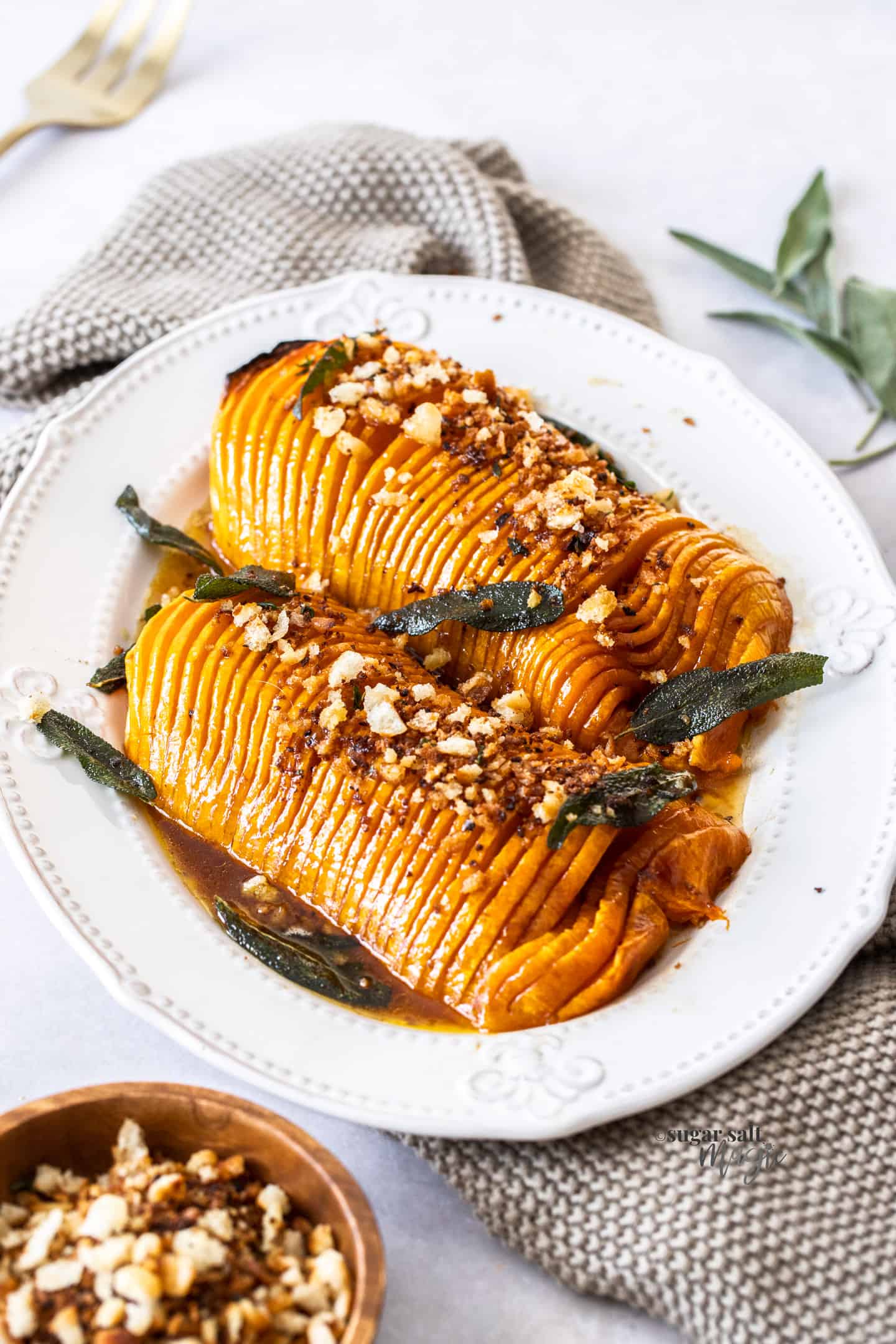
Why you’ll love it
I roast butternut squash almost as often as I turn it into butternut soup – it’s such a versatile veg and so full of flavour and we love it in our house.
This hasselback butternut squash though is something really special. It’s impressive enough to serve at your Thanksgiving or Christmas dinner but easy enough for just a regular roast dinner day.
Dressed with a maple-balsamic glaze, the slices get sticky and tender with chewy caramelised edges. Then crispy brown butter sage and pangrattato (crunchy herby breadcrumbs) add just the right amount of savoury and crunch.
Tools you’ll need
- A sharp knife and solid cutting board.
- A vegetable peeler.
- A large baking sheet or casserole dish.
Ingredients you’ll need
This roasted butternut needs just a few simple ingredients.
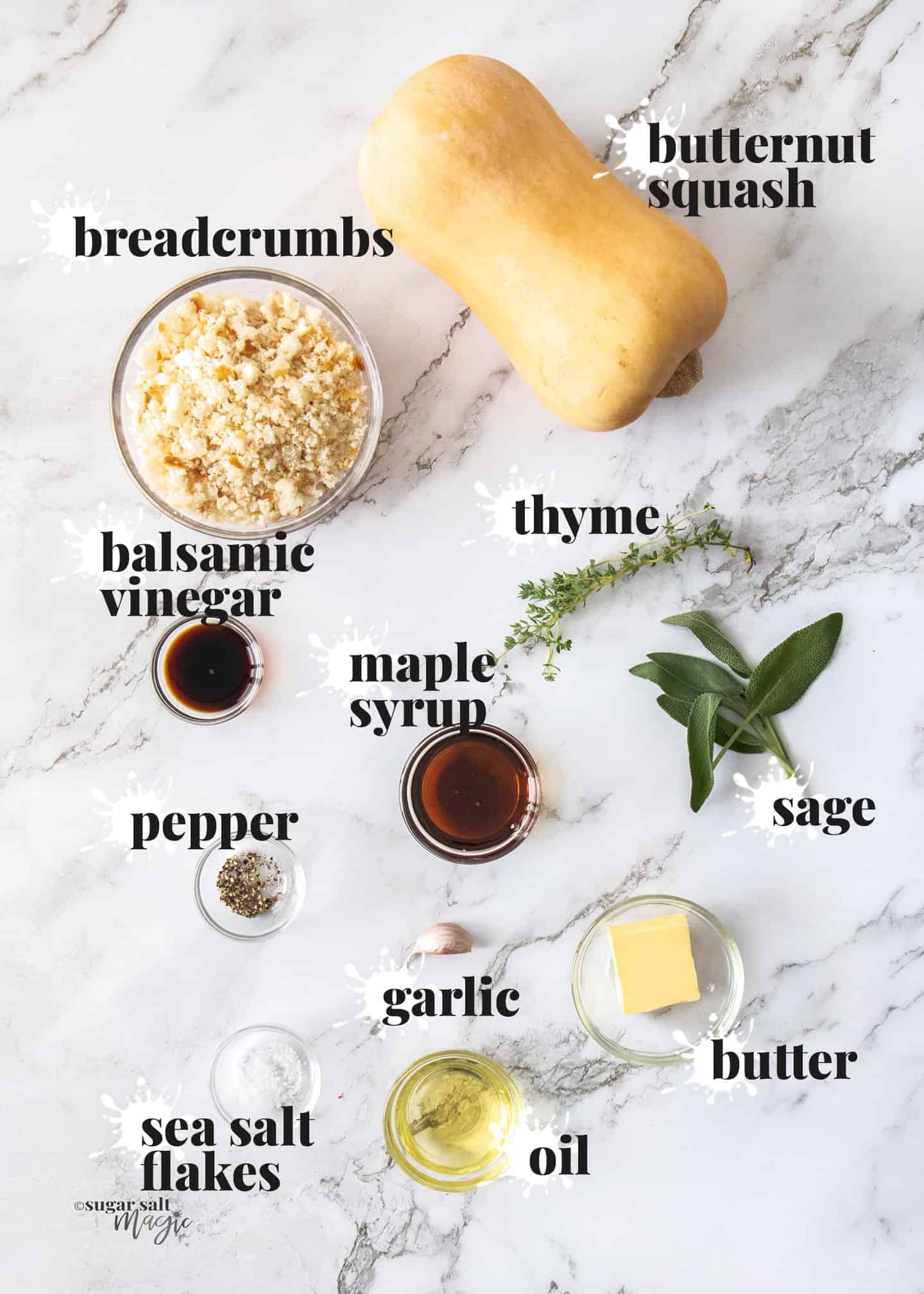
Detailed quantities and instructions in the recipe card below.
- Butternut squash: I use a single medium butternut. If you have a larger gathering to cater for, grab two as this recipe can easily be doubled.
- Sage and thyme: These herbs are perfect with butternut squash. The fresh sage leaves get crisped up in brown butter, and the thyme is used in the pangrattato topping.
- Breadcrumbs: Use fresh, quality bread – something like ciabatta works wonderfully and leftover bread that’s a bit stale is great too.
- Maple syrup: Intensifying the sweetness of the butternut, maple syrup is such a great flavour.
- Balsamic: A touch sweet but also acidic, it’s cuts through the richness.
- Butter: Butter is used in the glaze and for frying the sage leaves. You can use salted or unsalted.
- Garlic: Added to the breadcrumbs, this just gives them a little oomph of flavour and they don’t taste garlicy.
- Oil: You can use a good quality extra virgin olive oil or other vegetable oil.
- Salt and pepper: Sea salt flakes and freshly cracked black pepper is all the seasoning this needs.
You could also add some dried chili flakes for a little heat and you could toast some nuts with the pangrattato to add extra crunch too.
What is pangrattato?
So, I’ve mentioned pangrattato a few times. Pangrattato means breadcrumbs in Italian and is often referred to as ‘poor mans parmesan’. It is neither just breadcrumbs nor poor anything, IMO.
Pangrattato is breadcrumbs, a little oil, herbs and garlic sauteed until crunchy. It often adorns pasta dishes and would be wonderful served on top of this chicken basil pesto pasta or celery pesto rigatoni.
How to prepare butternut squash
Butternut is very simple to prepare but it is hard so take care when cutting into it.
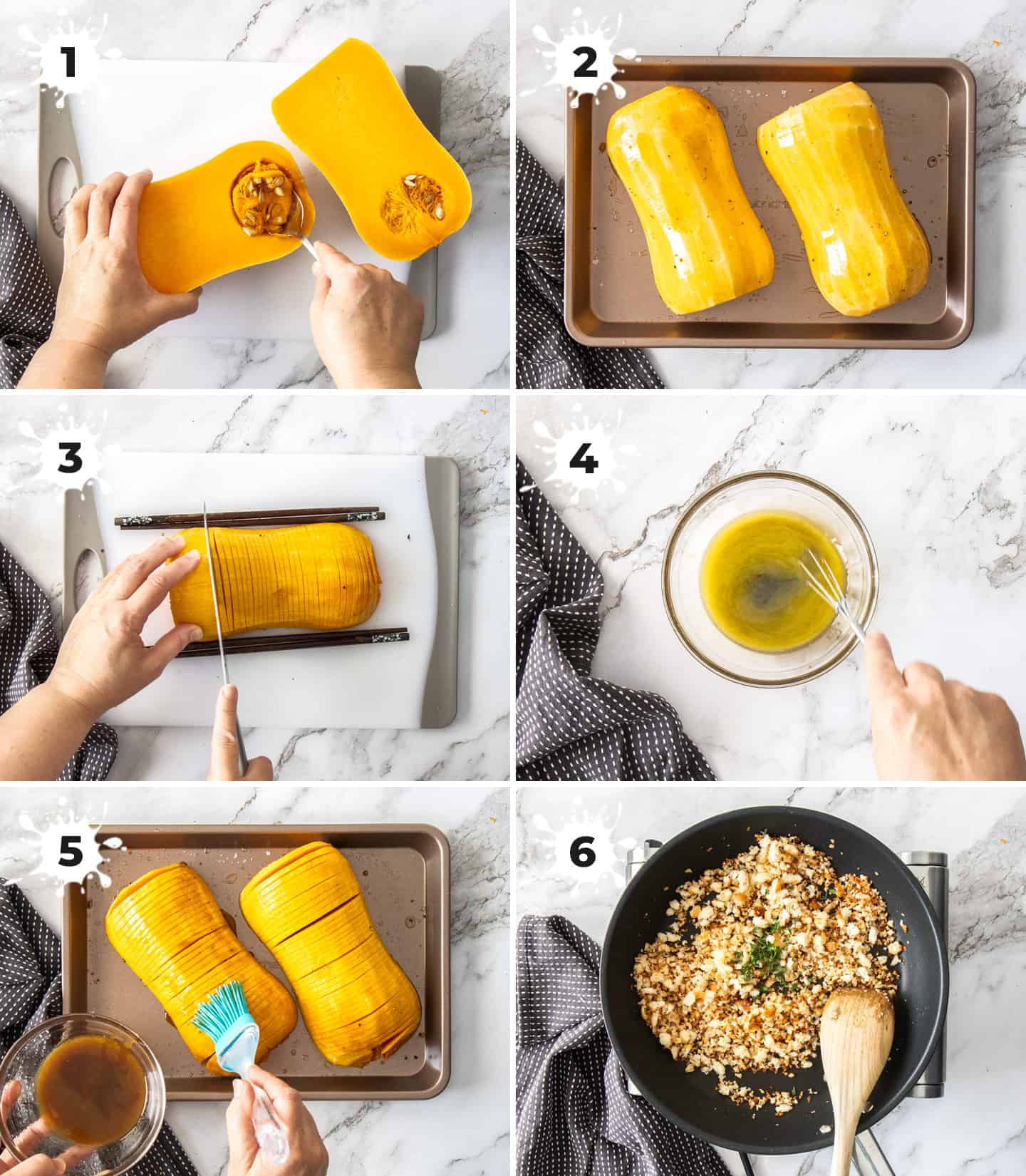
- Cut the squash: Start by cutting the stem end off. Now stand it on it’s base (the large round part) making sure it’s flat to the chopping board. Cut downwards through the centre with one hand on top of the squash to keep it stable and the other pushing the knife down. Please don’t put your hand below the knife.
- Remove the seeds: Use a spoon to very simply scoop out the seeds (photo 1). You can save those for roasting later or discard them.
- Peel the squash: Use a vegetable peel to peel away all the skin and place the halves on your baking sheet.
How to make hasselback butternut squash
You’ll love how simple the wonderful dish is to make.
Detailed instructions in the recipe card below.
- Season the squash: Rub a little oil, sea salt flakes and cracked black pepper all over the halves (photo 2). Roast for 20 minutes.
- Slice the squash: After it’s roasted a little it will be a bit softer and easier to slice. Place the handles of wooden spoons or thick chopsticks, either side of the squash on a chopping board. Using a sharp knife, cut thin slices (photo 3), stopping at the spoon handles or chopsticks so they all still hold together.
- The glaze: Whisk together the glaze ingredients (photo 4). Place the squash halves back on the baking tray – hasselback side up – then brush half of the glaze over the top (photo 5), letting it seep down between the slits. Roast again.
- The pangrattato: While the butternut is roasting, you can make the pangrattato which takes all of 5 minutes. Just fry the breadcrumbs in a little oil until golden (photo 6), then add the thyme and garlic, cook for another minute and they’re done.
Ok, I know the glaze has the sweet maple syrup and a little sweet balsamic but there isn’t a lot. The kicker here is that these flavours go beautifully with butternut squash. You can of course, leave the glaze off but I urge you to give it a go.
The crispy sage
These crispy leaves of sage add flavour and texture to the dish and are so simple to make.
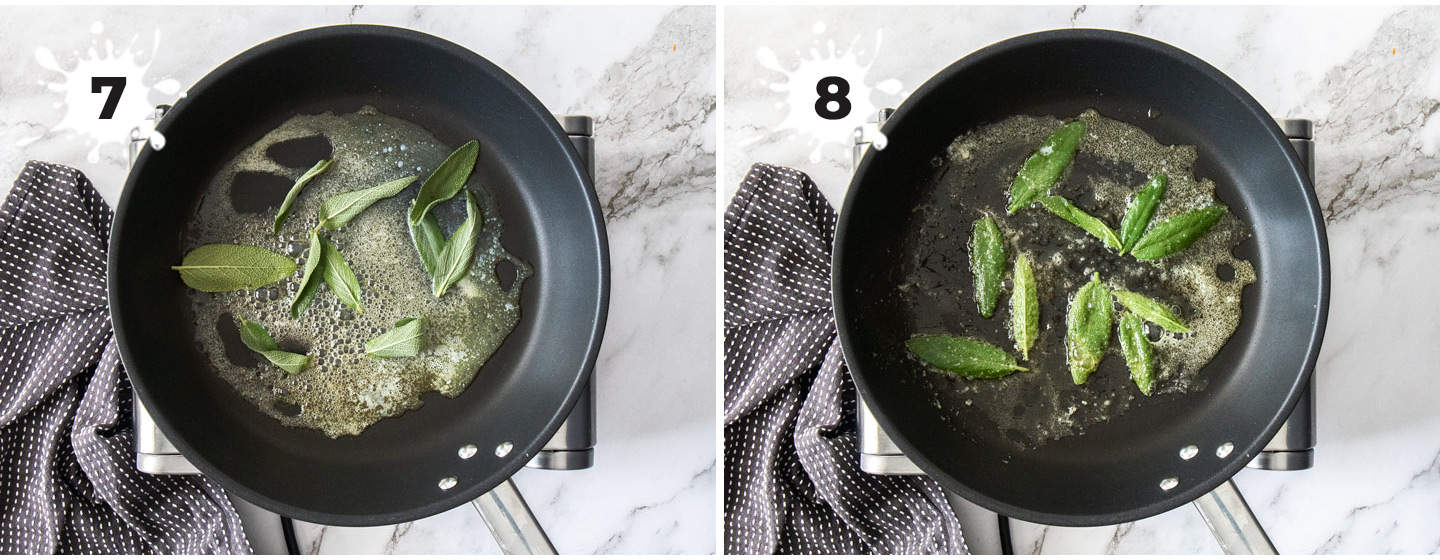
Detailed instructions in the recipe card below.
- Melt some butter in a pan or skillet over low-medium heat. Add the sage leaves (photo 7) and fry until crispy (photo 8) being careful not to let the butter burn.
This sage butter is also wonderful served with this crispy oven roasted pork belly.
How to serve it
- Transfer the squash, hasselback side up, to a platter (a fish slice makes this really easy).
- Spoon over a little of the pan juices.
- Scatter over some of the crumbs and all the sage leaves.
- Leave extra breadcrumbs in a bowl on the side so people can help themselves to more.
- Add a serving spoon and place it in the middle of the table for everyone to dig in.
Team it up with these Roasted shallots for a fabulous thanksgiving dinner. If you want to simply roast the butternut, you could then top it with this Sage butter sauce.
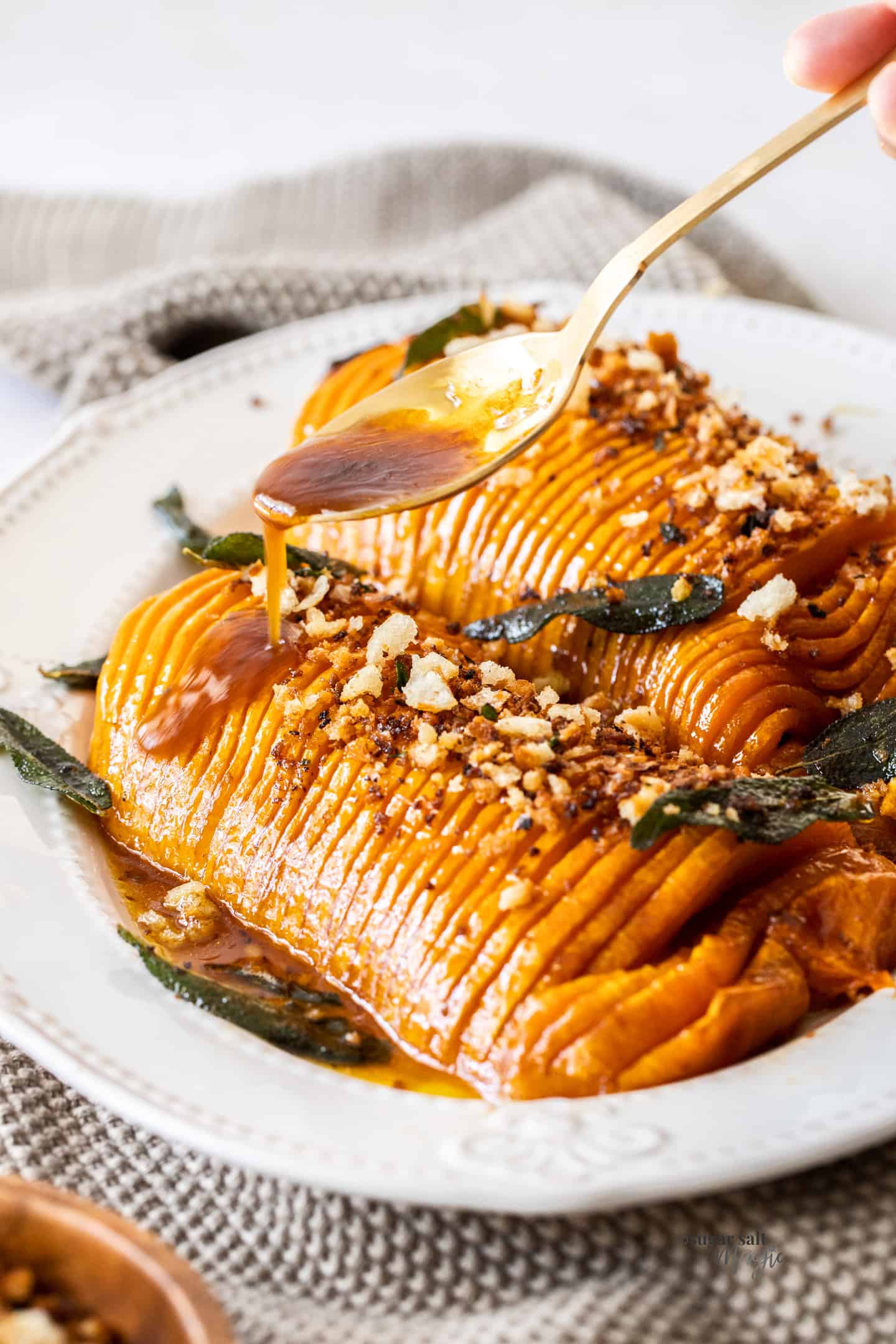
Tips and tricks
- Make sure not to cut all the way through, when cutting the hasselback slices. The wooden spoons or chopsticks on the side will help with this as your knife will hit them and not let you go any further, so make sure they are of a decent thickness. If you do cut through, don’t worry, just roast it anyway.
- Be careful when transferring the butternut to the baking sheet. Even though it’s all connected along the bottom, it’s still delicate. I find a fish slice or a really long spatula makes this very simple.
- Feel free to leave off the glaze. If you don’t want the extra sweetness and want just the natural butternut flavour, just leave the glaze off but do the rest of the seasoning and roasting the same way.
- When frying the sage leaves: A pale coloured pan will make it easier to keep an eye on the colour but if your pan is dark, just dot a little of the butter on a white plate to check the colour. Keep the temperature no more than low-medium.
- The sage leaves are done when they change to a darker colour all over.
Storing leftovers
Leftover hasselback butternut squash will keep well in the fridge, covered in plastic wrap or in an airtight container for 4-5 days. Eat it cold in a salad or sandwich or reheat it in the microwave or the oven.
The leftovers can also be pureed in a blender (doesn’t matter if a few crumbs make it into the mix) and turned into butternut squash soup.
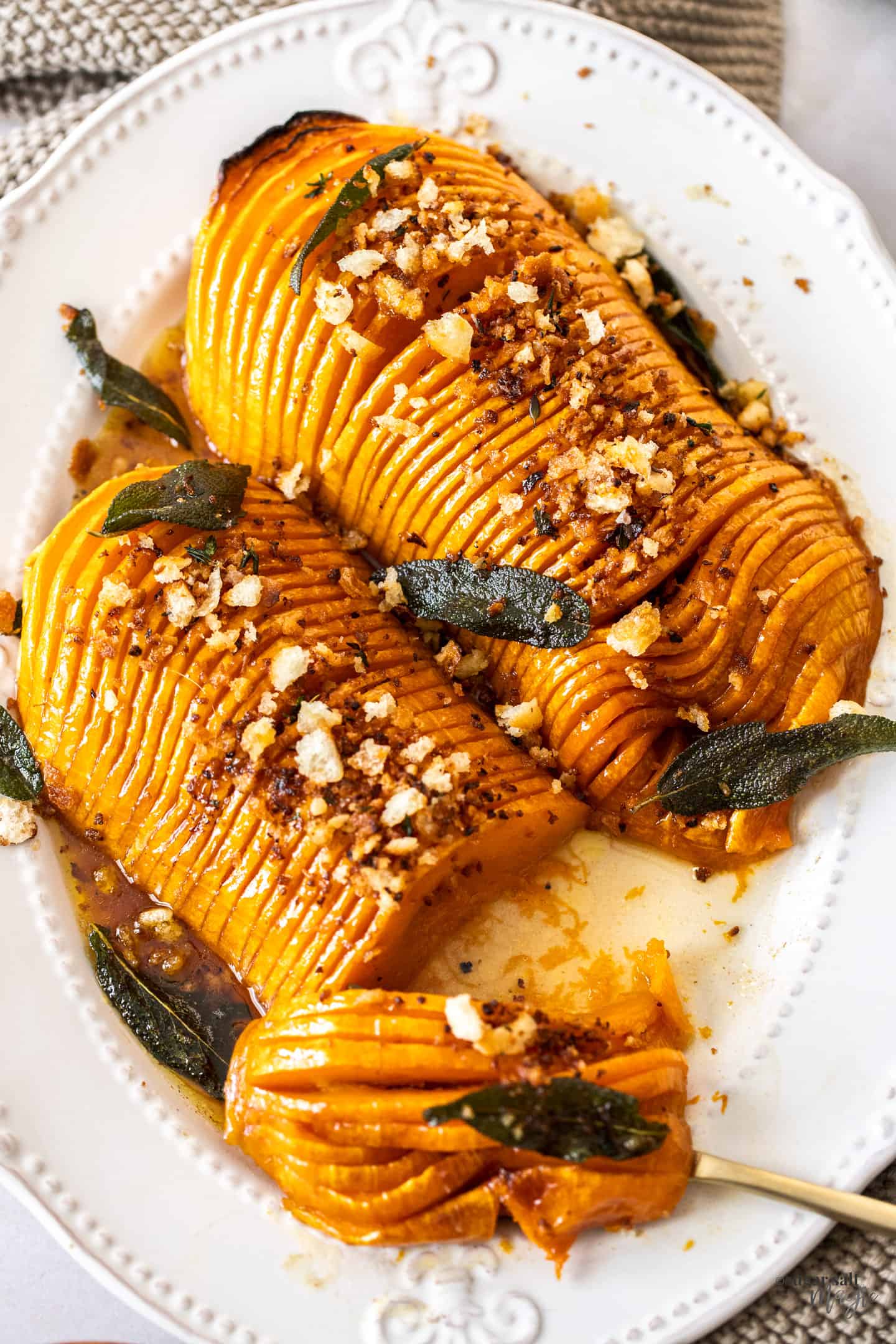
If you try this hasselback butternut squash recipe, please take a moment to leave a rating and comment below. I love hearing from you and it helps other readers too! You can also take a photo and tag @sugarsaltmagic on Instagram.
More recipes you’ll love
- Slow Cooker Turkey Breast
- Potato and Bacon Tart
- Air Fryer Corn on the Cob
- Rainbow Vegetable Tray Bake
- Stovetop Pumpkin Mac and Cheese
- Perfect Roast Potatoes
- Hasselback potato gratin
Never Miss a Recipe!
Get the latest recipes straight to your inbox!
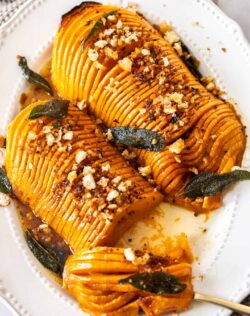
Ingredients
- 1 medium butternut squash (1.4kg / ~3lb)
- 2 ½ tablespoons extra virgin olive oil (notes)
- 1 teaspoon flaky sea salt
- ¼ teaspoon freshly cracked black pepper
- ¼ cup salted butter (57g / 2oz / 1/2 stick)
- 2 tablespoons pure maple syrup (notes)
- 2 teaspoons balsamic vinegar
- 1 cup fresh bread crumbs
- 2 teaspoons fresh thyme leaves
- 1 large clove garlic
- 10-12 sage leaves
For best results, always weigh ingredients where a weight is provided
Equipment
- Large baking tray
- chopsticks or wooden spoons
Instructions
- Preheat to 220C / 425F / 200C fan forced. Line a large baking tray with foil (to make clean up easier).
- Cut squash in half. Scoop out the seeds and peel the outside. You can save the seeds for roasting or discard with the peel.
- Rub the butternut with 1 tablespoon olive oil, ½ teaspoon sea salt flakes and the all the pepper.
- Roast for 20 minutes then transfer the butternut to a chopping board. Let it cool for 5 minutes while you make the dressing.
- For the dressing, melt half the butter (28g / 1oz), then whisk in the maple syrup and balsamic. Set aside.
- Place a wooden spoon or chopsticks along each long side of the butternut, then make cuts close together only as low as the chopsticks so you don’t cut all the way through.
- Use a fish slice or large flat spatula to help you transfer the butternut back onto the baking tray, hasselback side up. Brush with half the butter mixture, slowly so some of it seeps down into the slices. Roast for 20 minutes.
- Brush the remaining butter mixture over the butternut halves, drizzle 1 tablespoon of water around the pan, then place back in the oven for a further 20 minutes.
TO MAKE THE PANGRATTATO
- Add the remaining oil (1 ½ tablespoons) to a frying pan or skillet over medium heat. Once hot, add the breadcrumbs and remaining sea salt (½ teaspoon) and fry stirring often, until turning golden (3-4 minutes).
- Add the thyme leaves and garlic and fry for a further 1 minute. Transfer to a bowl and wipe out the pan.
TO MAKE THE FRIED BUTTER SAGE
- In the same pan over medium heat, melt the remaining butter (28g / 1oz). Add the sage leaves and let it cook and foam, stirring and turning the sage from time to time, until the butter turns amber / brown in colour and the sage is crispy. If you’re using a dark pan, just scoop a little of the butter onto a white plate so you can see the colour. Set the butter and sage aside.
TO SERVE
- Transfer the butternut halves to a serving platter. Drizzle over the juices from the pan and sage butter and then scatter on the pangrattato.
Notes
- This recipe is easy to scale up. You can double or even triple depending on the number of people you’re feeding.
- Leftovers (lucky you) are lovely in sandwiches or warmed up again. You can also turn it into butternut soup.
This post may contain affiliate links that earn me a small commission for my referral, at no extra cost to you. Thank you for supporting Sugar Salt Magic.

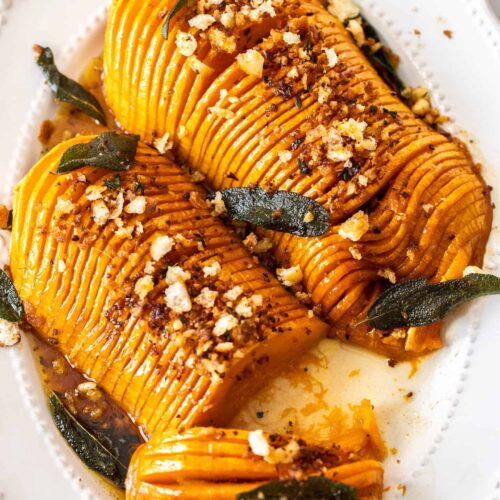
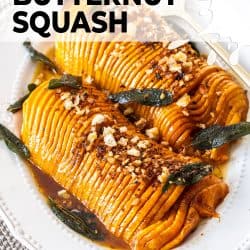

4 Comments on “Hasselback Butternut Squash”
Absolutely Delicious!!!
Love this recipe and so do my family and friends. A little Paprika is a great addition and you can tailor this with any other herb or spice to your liking. I have cooked this very successfully multiple times and I hide the left-overs for me to enjoy . . . all to myself 🙂 Do give it a go, you won’t be disappointed!
Yes! I’m so happy to hear this, Jenny. This is such a favourite in our house. Thanks for dropping back to review and your great tips – I haven’t tried the paprika yet (strange, since I love it paprika so much) but I certainly will next time.
Such a beautiful and delicious way to serve butternut squash, and the presentation is stunning!
Thanks Ben. The presentation is perfect for an extravagant meal but it’s so easy to do.